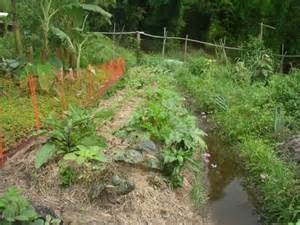
A few years ago, we heard from Toby Hemenway who wrote Gaia's Garden: A Guide to Home-Scale Permaculture. I studied this book and was very interested in the part he wrote about swales in the garden.
I wanted a habitat garden with native plants in one area of my property. A habitat garden gives small animals places to hide, provides nectar plants for insects and is low maintenance.
I decided that swales were going to be part of this garden since the rainwater needs somewhere to drain. Some swales are filled with twigs and covered with soil, but I wanted my swales to be open so they could be cleaned and so that I could observe what the water was doing. One of my neighbors refers to my swales as “Penny's lakes.”
The ground around the swales has to be saturated from rain before they start to hold water. The water should not remain in the swale more than three days; over that time, it should slowly be absorbed into the soil. The swale creates a damp area where plants can get water during dry periods. My friends are used to me saying,“The swales are full!”
About three years ago, the soil from the swales was mounded and planted with California natives and other low-water-use mediterranean plants. For the first couple of years, I watered them as needed, but last year this area received no water during the entire summer. I may decide to plant some native milkweeds there this fall; if so, I will need to water them next summer.
Mulching is one way to keep plants alive during dry spells. You can mulch with your own compost (if you're not already composting, you can learn to do it in a Master Gardener composting workshop). Or you can buy compost from companies that grind bark and wood into mulch.
After watering the ground well, spread three to four inches of mulch over the soil. You will be amazed how well it keeps water in the soil and available for plants.
Some of the plants I like to use are lavender, lamb's ears, salvias, monkey flower (mimulus), lily-of-the-Nile and yarrow. Some monkey flowers are sticky; others are not. Both types have beautiful flowers in a variety of colors and bloom almost continuously. With a little deadheading they grow right back.
My lavenders have a long bloom period, and bees enjoy them from morning until dusk. Whatever plants you choose, plant them in multiples to make a bigger splash of color and texture.
Local “Cash for Grass” programs are ongoing. You must apply to the City of Napa or American Canyon, and officials will come inspect your grass. Be sure to keep it alive until then. If approved, you will receive a grant to replace your grass. Then you can proceed with plans to create a habitat garden, dry garden, succulent garden or other garden of your choosing.
Walk your neighborhood to see what others have done. Peruse books for design ideas and visit local nurseries for plant suggestions.Gather information before you start.
You don't have to tear out your lawn. You can cover it with large pieces of clean cardboard, and then cover the cardboard with lots of mulch. Worms and other micro organisms will eat the cardboard and decompose it for you. In a few months you will have a dead lawn and some good soil to plant in.
If you're resourceful, drought does not mean the end of your landscape; it just means a different way of doing things.
Workshop: Napa County Master Gardeners will lead a workshop on “Drought-Tolerant and California Native Plants” on Saturday, August 1, from 9:30 a.m. to 11:30 a.m., at Martha Walker Garden in Skyline Park in Napa. Enjoy a walk around the garden to observe drought-tolerant and native plants, and discover the elements that help them thrive in our Mediterranean climate. Learn how to use them in your own garden to replace some of those water-hungry ornamentals.On-line registration (credit card only) Mail-in registration (cash or check only)
Master Gardeners are volunteers who help the University of California reach the gardening public with home gardening information. Napa County Master Gardeners ( http://ucanr.org/ucmgnapa/) are available to answer gardening questions in person or by phone, Monday, Wednesday and Friday, 9 a.m. to Noon, at the U. C. Cooperative Extension office, 1710 Soscol Avenue, Suite 4, Napa, 707-253-4143, or from outside City of Napa toll-free at 877-279-3065. Or e-mail your garden questions by following the guidelines on our web site. Click on Napa, then on Have Garden Questions? Find us on Facebook under UC Master Gardeners of Napa County.
Attached Images:
